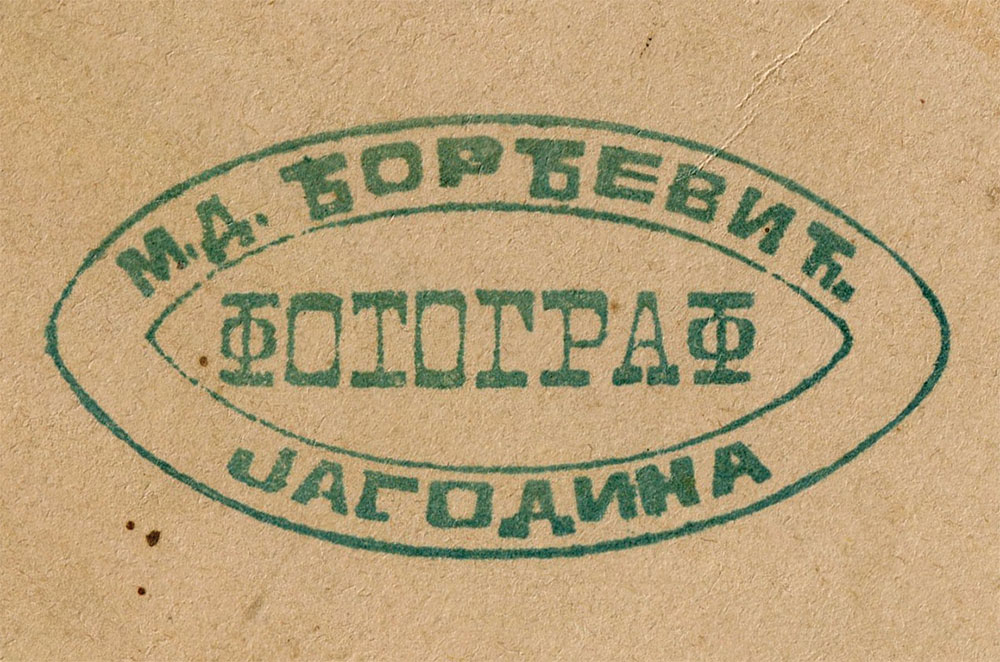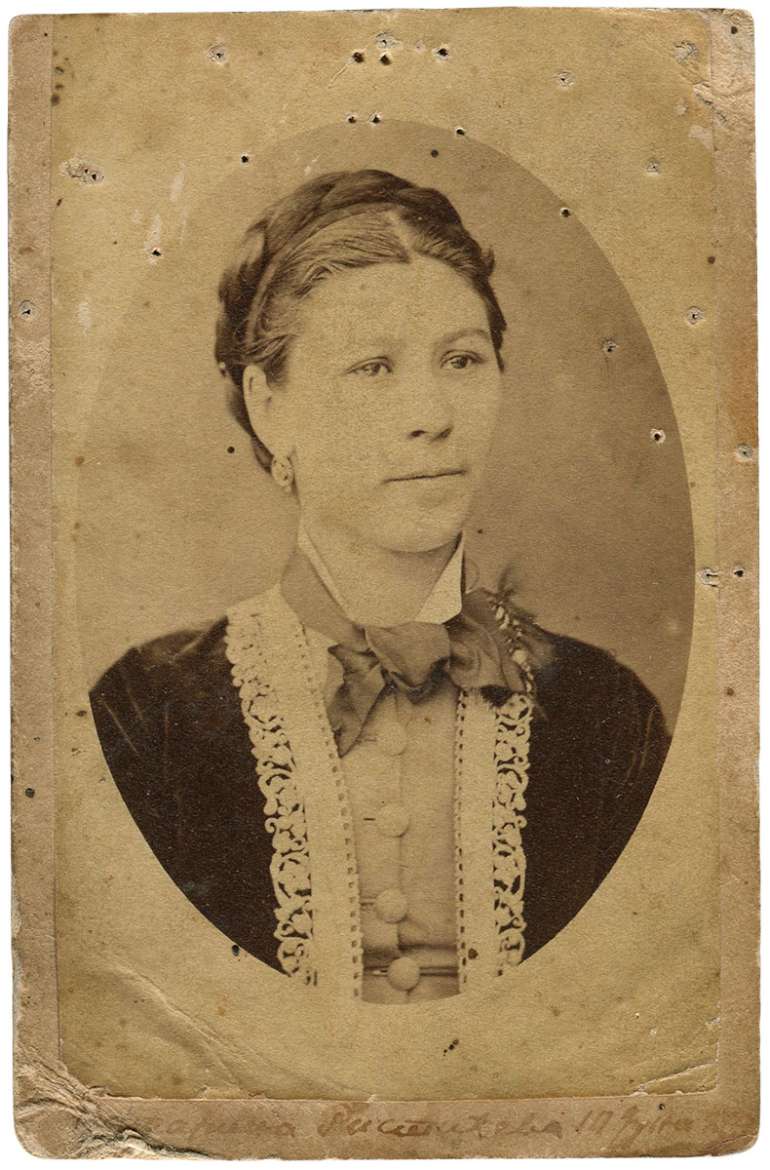Virtual Gallery of the Regional Museum of Jagodina
Author of the exhibition: Jasmina Trajkov

Virtual exhibition
According to current knowledge, the first photography studio in Jagodina is associated with the name of Franz Baubin, a photographer who came from Prague and who worked in our city in the early seventies of the 19th century. After him, also during 1870s, permanent photography studio in Jagodina were owned by Emanuelo Klar and M. Georgijević. It was considered to be a usual practice of partnership work in Serbia at that time. The photographer, a foreigner, would open a studio with a local partner who would help him financially and learn the craft. New data sheds a different light on the work of these photographers, primarily Georgijević (Đorđević). Not only does the time of his activity in Jagodina move closer to the first half of the eighth decade of the 19th century, but it is known that this is the name of the first resident of Jagodina who was professionally engaged in photography.
Mihailo Đorđević was born in Jagodina on October 19, 1851. His father’s name was Dimitrije and mother’s Milica. He had a brother who worked as a coachman in Jagodina and a sister who married the Jagodina cafe owner Pavle Ivković. His photographic work in Jagodina is evidenced by the reverses of photographs from the collection of the Regional Museum of Jagodina. Đorđević worked in our city until the middle of the eighth decade of the 19th century, and according to the testimony of Aleksa Mijović, a photographer from Kragujevac, during 1876 and 1877 he lived and worked in Kragujevac, where he was in contact with Mijović. After that, according to Mijović, he went to Turkey. In Kragujevac, he had no real estate, property or family. According to Mijović, for which he submits a receipt as proof, Đorđević owed him a certain amount of money and an unpaid bill for chemicals. The assumption is that Đorđević was engaged in photographic work in Kragujevac, most likely unreported. In the same year when Đorđević left Kragujevac, Mijović was looking for an assistant, but for now there is no confirmation whether he may have worked for this photographer from Kragujevac during his stay in this city.
For the period from 1877 to 1887, there is no information about the work of Mihailo Đorđević, so it is not known whether he spent this time working on the territory of Turkey, that is, outside of Serbia.
At the beginning of May 1887, he was issued a passport in Niš. This document reveals that Mihailo Đorđević, a photographer by profession, aged 36, traveled to Wallachia. He arrived in Negotin on May 13, 1887, crossed the border the next day at Radujevac, and then traveled through Romania. At the end of August 1887, it was located in the Dobruja region. He stayed here until the middle of 1888, changing places of residence. At the beginning of December 1888, he registered in Niš at the Turkish Consulate, and on December 13, he moved to the territory of this country. Đorđević worked for some time in Thessaloniki as a photographer, and then went to Yenidze-Vardar (today Janica), a place 56 km from Thessaloniki, where he worked until his sudden death. He died of complications caused by severe angina on January 26, 1891 in Yenidze-Vardar and was buried there.
In the collection of the Regional Museum in Jagodina, there are seven photographs with the name of the photographer Mihailo Đorđević. Separately, the seal with the name of Đorđević is found on the reverse of only one photograph. It features a family from Jagodina. An older woman is sitting, and a younger woman and a boy are standing next to her. In the background is a neutral canvas, on the floor is a thin patchwork, on the right side it can be seen a part of a small table. The cardboard is cut, most likely homemade, with an elliptical stamp with the photographer’s name on the reverse “M. D. Đorđević photographer of Jagodina”.
The next two photos have an interesting combination of photographer’s names. On the obverse side of the cardboard, a thin dark red line delineates a rectangular frame, inside which is a laminated photo. On the bottom line of the frame is printed the photographer’s name “E. Klar”, on the left in Latin, on the right in Cyrillic. On the reverse side of these photos is the already described elliptical stamp with the name of Mihailo Đorđević. Both photos show the bust of a young man. On one of them, the figure is placed in an oval on a neutral background. This way of creating portraits is still found in Klar’s photographs.
The remaining four photos are laminated on cardboard with the name of the studio printed on the reverse “Photographic workshop by Em. Klarović and M. Georgijević in Jagodina”. On the first, a standing figure of a young man was photographed. It can be seen a neutral canvas in the background and on the floor there is the patchwork already present in the earlier photos. The second photo shows Katarina Ristić’s bust, in an oval on a neutral background. This photograph at the bottom of the obverse has a dedication with the date June 10, but the last digit of the year is illegible, so all that remains is that the photograph was taken in the seventies of the 19th century. The exact year from the dedication in this photo would be useful for establishing a more precise date of work of the partnership studio of Klar and Đorđević.
The next two photos have a dedication with a date. These are the portraits of sisters Timić, Jelena and Hristina. One portrait has a dedication dated May 14, 1878, and the other dated October 16, 1878. On the reverse side of both photos with a printed label of the photography workshop Em. Klarović and M. Georgijević, the name of Georgijević (Đorđević) is crossed out, which indicates that Klar used the existing stock of cardboard-substrates, but that he was no longer in partnership with Đorđević. There are also reverses of Klar’s photographs with the same artistic solution as those with the label of the partnership studio, but with the inscription “Photographic workshop by Em. Klarović in Jagodina”. This, among other things, leads to the conclusion that Klar continued to work independently.
In addition to photographs with the stamp of Mihailo Đorđević’s studio, a document dated January 26, 1891 with a list of things that were found in Đorđević’s photography shop in Yenidže-Vardar after his death is kept in the Regional Museum in Jagodina. This document is significant because it provides information on the inventory of a photographic shop from the 19th century.
For now, not a single recording that was made in Đorđević’s photography studio in Yenidže-Vardar is known.
You can find out more about this photographer in this paper: J. Trajkov, Mihailo Đorđević (1851-1891), photographer from Jagodina, aditions to the biography, Koreni X, Jagodina 2016, 115–122.







